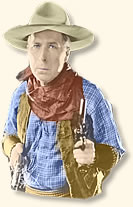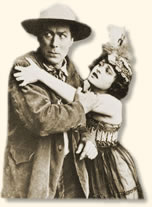|
Birth of the Hollywood Cowboy, 1911
William S. Hart was Hollywood's first cowboy star. His portrayal of the western hero as strong, silent, rough around the edges - but true to an internal code of honor - influenced his successors from John Wayne to Clint Eastwood.
The initial image of the cowboy in American popular culture was not a positive one. Dime novels and publications such as the Police
Gazette of the 1880s often portrayed him as a rowdy and unscrupulous drunkard, prone to shooting up the cattle towns he encountered as he guided his cows from the range to the railhead.
 |
| William S. Hart |
This perspective changed under the influence of Buffalo Bill Cody's Wild West Show, artists such as Frederic Remington and Charles Russell as well as books such as the Virginian (1902) that painted a more romantic portrait of the cowboy as a lonesome hero.
The first narrative film - The Great Train Robbery produced in 1903 by
Edwin S. Porter - was a western. Although shot entirely on the East Coast,
it contained the essential elements that made the Western a staple of the Hollywood
film industry for the next 100 years. Ten minutes in length, it was action-packed
with a train robbery, a chase and a final shootout. It was an enormous success
and the most profitable film of its time.
William S. Hart was born in New York in 1865 and traveled West with his family as a child. He made his way back east as a young man intent on becoming an actor and eventually won acclaim for his portrayal of Messala in the stage version of "Ben Hur."
Although successful as a stage actor, Hart was feeling unchallenged. A chance viewing of a movie western energized the stage actor's determination to make films.
We join Hart's story in 1911 as he sees his first western movie that sparks his determination to make cowboy films:
"While playing in Cleveland, I attended a picture show. I saw a Western picture. It was awful! I talked with the manager of the theater and he told me it was one of the best Westerns he had ever had. None of the impossibilities or libels on the West meant anything to him - it was drawing the crowds. The fact that the sheriff was dressed and characterized as a sort of cross between a Wisconsin wood-chopper and a Gloucester fisherman was' unknown to him. I did not seek to enlighten him. I was seeking information. In fact, I was so sure that I had made a big discovery that I was frightened that someone would read my mind and find it out.
Here were reproductions of the Old West being seriously presented to the public - in almost a burlesque manner - and they were successful. It made me tremble to' think of it. I was an actor and I knew the West...The opportunity that I had been waiting for years to come was knocking at my door.
...Rise or fall, sink or swim, I had to bend every endeavor to get a chance to make Western motion pictures. Usually when I was stirred by ambition I became afraid. But surely this could not be the valor of ignorance. I had been waiting for years for the right thing, and now the right thing had come! I was a part of the West - it was my boyhood home - it was in my blood. I had a thorough training as an actor. I was considered the outstanding portrayer of Western roles everywhere on the American stage.
The remainder of the season I visited all picture shows wherever possible. During the summer at Westport and on trips to New York, I did the same. I talked to my actor friends in The Lambs Club who were working everyday playing Western parts in pictures being made over in Jersey. I was secretive. I told them nothing of my great plans. When it came time for 'The Trail of the Lonesome Pine' to open again, my reluctance to take an engagement before trying my pet scheme caused me to raise my salary to $175 a week. While waiting for their answer, I met an actor who was going to California to work in Western pictures.
'The Trail of the Lonesome Pine' was going to California. I was frightened! They might refuse to give me the part on account of the raise in salary. I was on the point of writing them that I would go for any salary, when they wrote me O.K.
The finger of Fate was pointing in the right direction.
Fortunately, we came West immediately after opening. At San Francisco I learned
that all the principal studios were in Los Angeles; that the principal companies
making Westerns were the Universal Picture Corporation in Hollywood, and the
New York Motion Picture Company working in conjunction with the 101 Ranch [a
Wild West show]
.
When we reached Los Angeles, while a friend was registering for me, I went into a telephone booth, called up the New York Motion Picture Company and asked for Joe Miller. A man who said his name was Brooks answered, and said that Mr. Miller was not there, but that he represented him.
I then said, 'I am an actor and I want to see about making some Western pictures.'
He replied: 'Mr. Miller only owns the stock and the cowboy
end of the company. If you want to see about acting, call up Thomas H. Ince [an
old friend of Hart's]
- he is manager of the picture company.'
I did so.
 |
Hart's character was a
good/bad man who often found
redemption through a good woman. |
The next day Tom called and took me out to see the camp. I was enraptured and told him so. The very primitiveness of the whole life out there, the cowboys and the Indians, staggered me. I loved it. They had everything to make Western pictures. The West was right there!
I told Tom of my hopes, of my plans. I told him everything.
'Bill,' he said, 'it's a damn shame, but you're too late! The country has been flooded with Western pictures. They are the cheapest pictures to make and every company out here has made them. You simply cannot sell a Western picture at any price. They are a drug on the market.'
And to prove his statement, he showed me all the sets they were photographing on. The scenes were all laid in Ireland. 'But, Tom,' I cried, 'this means everything on earth to me. It is the one big opportunity of my life. Why all these cowboys? Why all these Indians?'
'Bill,' he said, 'it's a contract. The owners of this company have a contract with the 101 Show that has another year to run.' 'Fine,' I said. 'Let me make some Western pictures and use these people.'
'Bill,' he said, 'I know you; I know, if there was any possible chance, that you could put it over, but it just can't be done. I made a picture when I came out here, a Western picture, Custer's Last Fight, and I had all these Indians and cowboys. It was a fine picture, but it didn't sell.'
I didn't have any more to say. We walked all round the camp. When we were leaving, I talked in Sioux to some of the Indians, and Tom was so astonished. He walked back and said to a young Indian: 'What did he say?'
The Indian just smiled and would not answer, until I told him in Sioux to do so, and then he replied, truthfully, that I had said that I was going away from here, but that I wanted to stay here.
I was late leaving (they had to hold the curtain at the theater for me), but just as Tom was putting me in his car he said: 'Bill, if you want to come out next spring and take a chance, I'll give you seventy-five dollars a week to cover your expenses and direct you in a picture myself.'
'Tom,' I replied, 'I'll be here just as soon as we close. . . .' "
References:
This eyewitness account appears in Hart, William, S. My Life East and West (1968); Taylor, Lonn and Ingrid Maar, The American Cowboy (1983).
How To Cite This Article:
"Birth of the Hollywood Cowboy, 1911," EyeWitness to History, www.eyewitnesstohistory.com (2006).
|






